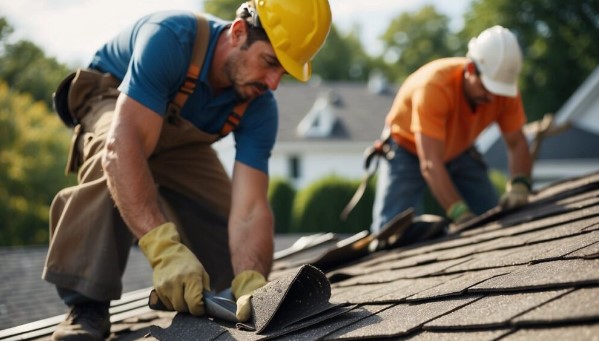Essential Steps to Ready Your Home for a Roof Replacement

A roof replacement is a significant home improvement project that can greatly enhance the protection and value of your home. Preparing your home for this extensive task is essential to ensure a smooth process and minimize disruptions. Proper preparation by D-ROC Renovations of Longmont can help safeguard your property, reduce stress, and facilitate a more efficient and successful roof replacement. We will explore various steps and considerations to help you prepare your home for a roof replacement. By following these guidelines, you can ensure a seamless and hassle-free experience.
Various steps and considerations for a roof replacement
1. Choosing the Right Contractor
Selecting a reputable contractor is one of the first steps in preparing for a roof replacement. Research local contractors, check their credentials, read reviews, and ask for references. Ensure they are licensed and insured and offer a warranty on their work. Meet with potential contractors to discuss your project, obtain detailed estimates, and ask any questions you may have. Choosing the right contractor ensures quality workmanship and a smooth roof replacement process. Review thoroughly vet contractors to find the best fit for your project.
2. Scheduling the Project
Once you have selected a contractor, the next step is to schedule the roof replacement. Discuss the timeline with your contractor and choose a start date that works for both parties. Consider weather conditions and upcoming events or commitments that may affect the project. It is important to understand the project timeline and any potential delays clearly. Scheduling the project in advance allows you to plan accordingly and make any necessary arrangements to accommodate the roof replacement.
3. Clearing the Work Area
Before the roof replacement begins, clearing the work area around your home is essential. This includes removing any vehicles, outdoor furniture, potted plants, and other items from your driveway, yard, and patios. Clearing the work area gives the roofing crew easy access to your roof and ensures their safety. Additionally, it helps protect your belongings from potential damage caused by falling debris. Carefully clear the work area to create a safe and efficient workspace for the roofing crew.
4. Protecting Interior Spaces
During a roof replacement, vibrations and debris can affect the interior of your home. To protect your belongings and minimize disruptions, take steps to secure your interior spaces. Cover furniture, electronics, and other valuable items with drop cloths or plastic sheeting to prevent dust and debris from settling on them. Remove fragile items from walls and shelves, such as picture frames and collectibles. It may also be helpful to temporarily relocate items stored in your attic, as vibrations can cause dust and debris to dislodge and fall. By protecting your interior spaces, you can minimize the impact of the roof replacement on your home.
5. Informing Neighbors
Informing your neighbors about your upcoming roof replacement is a considerate and practical step. Roof replacements can be noisy and disruptive, so it is courteous to inform your neighbors beforehand. Provide them with the project timeline and contact information for your contractor if they have any concerns or questions. Informing your neighbors helps maintain good relations and allows them to prepare for any inconveniences. Clear communication with neighbors can prevent misunderstandings and contribute to a smoother project.
6. Ensuring Child and Pet Safety
The roof replacement process can be hazardous for children and pets. Make arrangements to keep them away from the work area to ensure their safety. Consider having children stay with a relative or friend during the most intensive parts of the project. For pets, create a safe and secure space indoors where they can remain comfortable and away from noise and commotion. If you have outdoor pets, consider boarding them temporarily. Ensuring the safety of children and pets is a crucial aspect of preparing for a roof replacement.
7. Preparing for Noise and Disruptions
Roof replacements are inherently noisy and can disrupt your daily routine. Prepare yourself and your household for the noise and commotion by planning accordingly. If possible, schedule activities or errands outside the home during the loudest parts of the project. Consider using noise-canceling headphones or earplugs to minimize the impact of the noise. Communicate with your contractor to understand the daily schedule and plan your day around the work. Being prepared for noise and disruptions can help you manage the stress and inconvenience of roof replacement.
8. Protecting Landscaping
Your landscaping can be vulnerable to damage during a roof replacement. To protect your plants, shrubs, and flowers, create a buffer zone around the perimeter of your home. Use tarps or plywood to cover delicate plants and garden beds. If you have large trees or shrubs near the house, consider pruning them to give the roofing crew better access. Communicate with your contractor about any specific concerns you have regarding your landscaping, and they may be able to take additional precautions. Protecting your landscaping helps preserve the beauty of your yard and prevents unnecessary damage.
9. Ensuring Proper Ventilation
Proper ventilation is crucial for the health and longevity of your new roof. Before the roof replacement begins, discuss ventilation options with your contractor. They may recommend adding or upgrading vents, ridge vents, or attic fans to ensure adequate airflow. Proper ventilation helps prevent moisture buildup, which can lead to mold growth and roof deterioration. Ensuring proper ventilation is an important consideration during the roof replacement planning process. Addressing ventilation needs can improve the performance and lifespan of your new roof.
10. Reviewing the Contract
Before the roof replacement begins, carefully review the contract with your contractor. Ensure that all project details, including the scope of work, materials to be used, timeline, and payment terms, are clearly outlined. Address any questions or concerns you may have and ensure you fully understand the terms of the contract. Reviewing the contract helps prevent misunderstandings and ensures that both parties are on the same page. A clear and comprehensive contract is essential for a successful roof replacement project.
11. Arranging for Permits
Depending on your location, you may need to obtain permits for your roof replacement. Check with your local building department to determine the requirements and ensure all necessary permits are secured before the project begins. Your contractor may handle the permit process on your behalf, but it is important to confirm this and follow up as needed. Obtaining the required permits ensures that your roof replacement complies with local building codes and regulations. Proper permitting is a crucial step in preparing for a roof replacement.
12. Preparing for Clean-Up
A roof replacement can generate significant debris, including old shingles, nails, and other materials. Preparing for clean-up is an important part of the process. Discuss the clean-up plan with your contractor to understand how debris will be managed and removed from your property. Ensure that a dumpster or designated disposal area is available for the roofing crew. Additionally, consider using magnetic sweepers to collect any nails or small debris left behind. Preparing for clean-up helps maintain a tidy worksite and ensures your property is in good condition.
Read also: How to Choose the Right Roofing Company for Your Project
13. Planning for Weather Conditions
Weather conditions can impact the roof replacement process. Check the weather forecast leading to the project and discuss contingency plans with your contractor. The project may need to be rescheduled or temporarily halted in case of rain or severe weather. Ensure that your contractor has a plan for protecting your home from potential weather-related damage during the project. Planning for weather conditions helps prevent delays and ensures your roof replacement proceeds smoothly. Being prepared for changing weather can minimize disruptions and protect your home.
14. Communicating with Your Contractor
Effective communication with your contractor is essential throughout the roof replacement process. Maintain an open line of communication and address any questions or concerns promptly. Regular updates from your contractor can help you stay informed about the project’s progress and any potential issues. Clear communication helps ensure that the project stays on track and that any problems are resolved quickly. Building a positive relationship with your contractor contributes to a successful roof replacement.
Conclusion
Preparing your home for a roof replacement involves carefully planning and considering various factors. Each step is crucial for a smooth and successful roof replacement, from choosing the right contractor and scheduling the project to protecting your property and ensuring safety. By following these guidelines and maintaining clear communication with your contractor, you can minimize disruptions and ensure that your home is well-prepared for the project. Proper preparation helps protect your property and contributes to a more efficient and satisfactory roof replacement experience.




